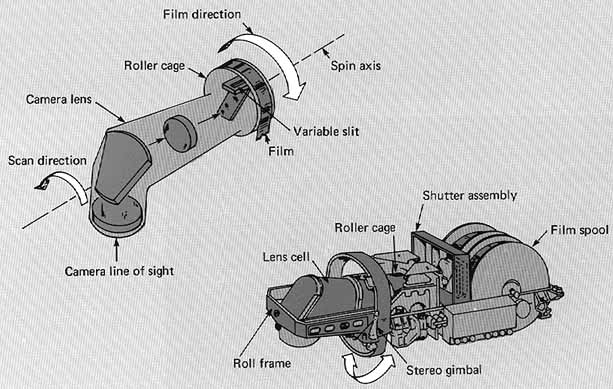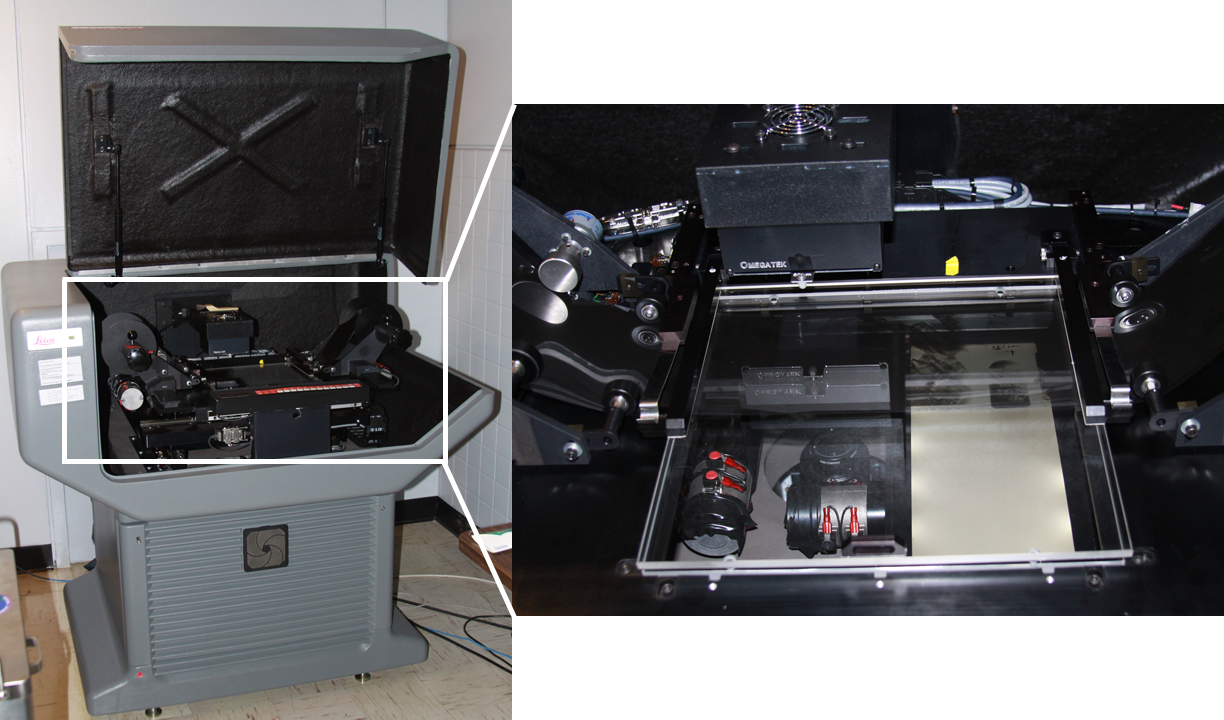
| Project Home | About the Scans | Browse Gallery | Image Map | Support Data | Resources | Ephemeris |
Featured Image - 11/30/2011
Apollo and LROC: New and Old Advancing Lunar Exploration
You might think that the LROC Narrow Angle Cameras are the first high-resolution cameras to orbit the Moon. Not so! In the early 1970's, the Apollo 15, 16, and 17 spacecraft flew Panoramic cameras (Pan camera) with 1-2 meter resolution, with the objective of providing stereo photography and searching for future landing sites for human crews. These cameras imaged the Moon. Since the Apollo Command and Service Modules were in a near-equatorial orbit, the Panoramic images are limited to those portions of the Moon. Today, these images provide an atlas of the lunar low- latitude regions that planetary scientists can compare to the LROC images to study how the Moon changed between 1970 and the present.
 Figure 1. The Apollo panoramic camera with the covers removed (NASA)
Figure 1. The Apollo panoramic camera with the covers removed (NASA)
The Apollo Panoramic cameras (Figure 1) were derived from an optical bar camera similar to those flown on the U-2 and SR-71 reconnaissance aircraft. Along with the Metric Camera the Pan Camera was flown in the Scientific Instrument Module (informally known as the SIM bay). From the Apollo 15, 16, and 17 missions 4545 Pan frames were shuttered. Once the command module pilot turned the Pan Camera on, it operated continuously, constantly rotating and exposing film in a 108° wide arc. This wide field-of-view equated to an area on the surface about 322 kilometers (200 miles) wide x 21 kilometers (13 miles) along the flight path. The camera was capable of moving in two axes (Figure 2): the roll assembly allowed for the movement across the flight track while the gimbal assembly allowed for movement along the flight path to allow for stereo imaging.
 Figure 2. Moving parts within the panoramic camera assembly that allowed
the camera to move along two axes: one along the flight direction, and the other perpendicular to the flight direction (NASA)
Figure 2. Moving parts within the panoramic camera assembly that allowed
the camera to move along two axes: one along the flight direction, and the other perpendicular to the flight direction (NASA)
Like the Metric film, the Panoramic film is now stored in a freezer at Johnson Space Center. For scanning, unlike the Metric film, each Panoramic frame must be divided into tiles. A single frame on the film is 11 centimeters (4.5 inches) wide and almost 1.2 meters (4 feet) long!
The Panoramic film is being scanned at Johnson Space Center on a Leica scanner with a scanbed that is approximately 10 by 10 inches (Figure 3). Each frame is divided into 8 tiles with about 14% overlap between each tile and at full resolution each tile is 2 GBytes in size. The images are scanned in sections because the scanner can only "see" 10 inches at a time, recall that the Pan negatives are 44" long. See Figure 4 for an example of what a complete complete and processed Pan frame looks like.

Figure 3. A view of the Leica scanner with the cover open (left) and a panoramic frame set up on the scanbed ready for scanning (right) (NASA/JSC)
 Figure 4. Processed Panoramic frame AS15-P-0076 downsampled by a factor of 16 from the full resolution JPEG2000 mosaic (NASA/JSC/ASU)
Figure 4. Processed Panoramic frame AS15-P-0076 downsampled by a factor of 16 from the full resolution JPEG2000 mosaic (NASA/JSC/ASU)
The following products are being released for each Pan frame:
- 8 raw-scan tiles (16-bit TIFF, 2GB each)
- A full-resolution mosaic of the raw tiles (JPEG2000 format, 6GB -generated at JSC from the raw scans)
- A stretched, reduced by a factor of two, middle portion (center 50%) of the JPEG2000 mosaic (8-bit PNG, 500MB)
- A 1/4 scale pyramidal image of the JSC mosaic (16-bit TIFF, 40MB)
- Stretched and downsampled versions of the JSC mosaic (8-bit PNGs at 1/4, 1/16, 1/64, and 1/256 scale, totaling about 250MB)
For more information about the Pan camera, please refer to:
Apollo Over the Moon: The View from Orbit. Harold Masursky, G. W. Colton, Farouk El-Baz - NASA SP-362, 1978
Apollo Flight Journal: The ITEK Panoramic Camera by Robin Wheeler.
Panoramic Photography Analysis by William C. Kinney.
Apollo Camera References

|
|
Space Exploration Resources |
|
 LPI LPI
|